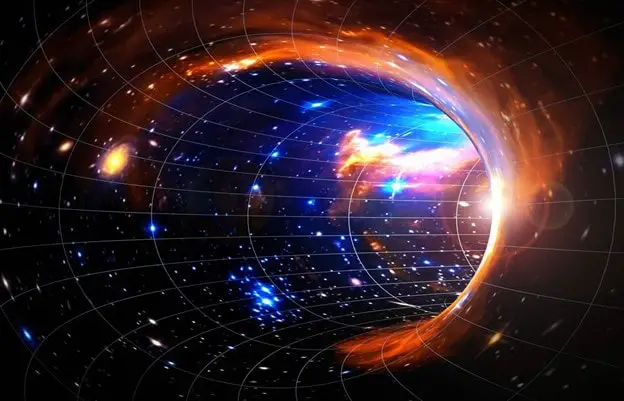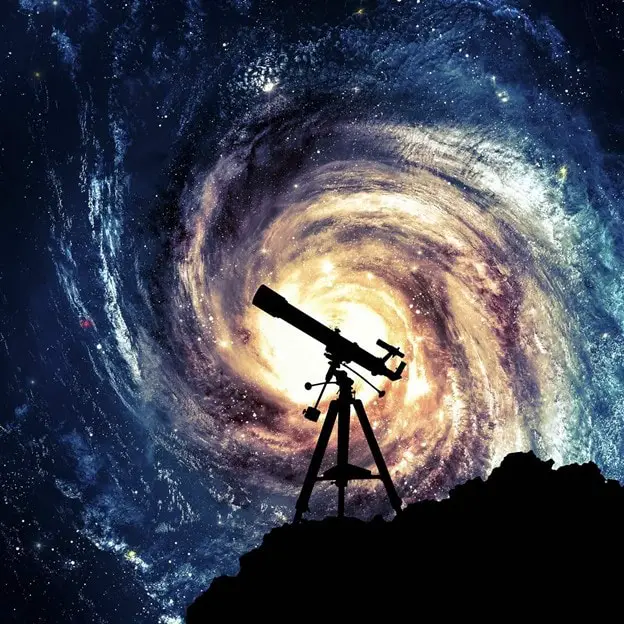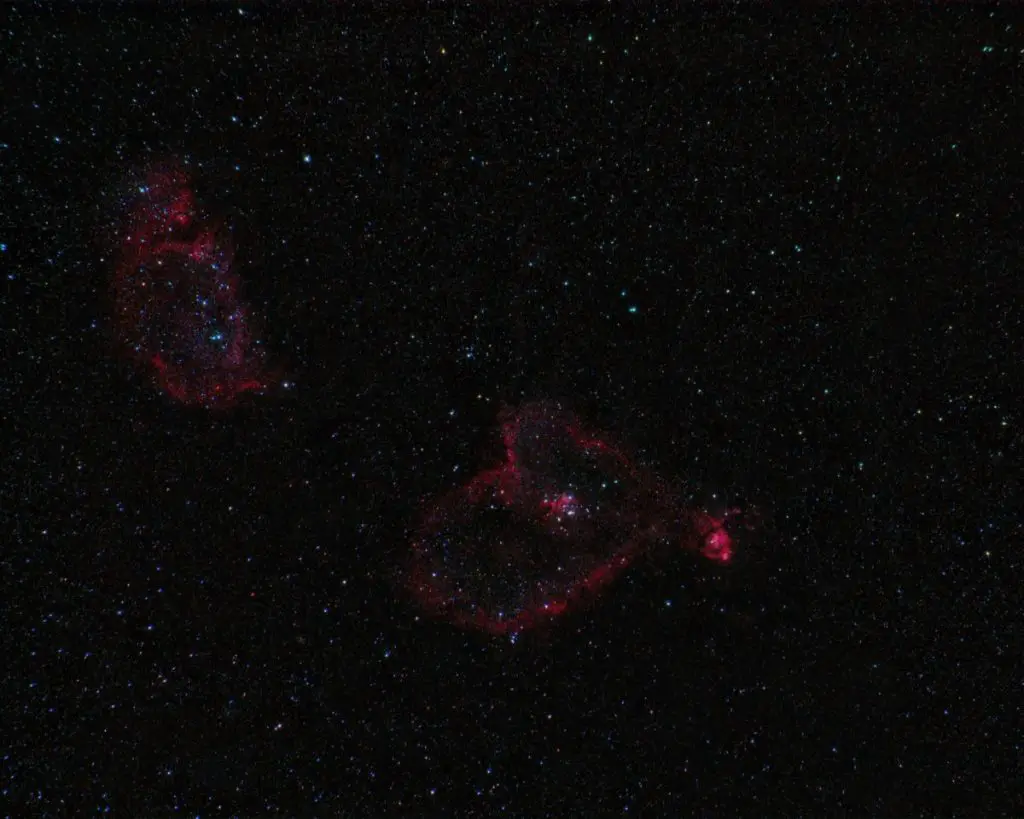
What does it mean when we hear that the universe is expanding? Well, the data received from the Hubble Telescope tells us that the galaxies located close to the Milky Way are actually speeding away from us. And this phenomenon is pervasive, no matter where in the universe you are.
The expansion of the universe is observed as an increase in distance between bodies that are gravitationally bound. It is a result of general relativity. It differs from any expansion that is perceived in daily life because the fabric of space itself is expanding along with large galaxies and star systems.
Cosmologists have measured radiation caused by the Big Bang to estimate the rate of expansion over time and used this data to predict how quickly the universe should be expanding. They found that the rate of increase does not fit with their theories — and to this day, this discrepancy (known as the Hubble Tension) has not been resolved. Read on to learn more.
What is Space Made of?
What we call the universe essentially encompasses all in existence. This includes everything from giant meteors and asteroids to the smallest atoms and light frequencies that the human eye cannot perceive.
Researchers have concluded that we can only see a tiny fraction of the universe — just about 5%. Even though much of the remainder of the universe consists of dark matter and dark energy, both are still not fully understood. Human eyes can only distinguish a small fraction of matter that emits or reflects light in the visible light spectrum.
The universe was formed some 13.7 billion years ago in what cosmologists call the Big Bang. Where exactly this event happened remains a mystery. As a result, scientists have not been able to establish a center from which the universe originates and expands.
How Does Space Expand?
The most commonly used analogy to describe how space expands is to imagine the entire universe as a loaf of raisin bread. As you bake the bread, it slowly expands and rises, causing the raisins to move away from each other while remaining in the expanding dough.
When you think about how this applies to the expansion of the universe, some galaxies (the raisins) have likely moved so far away that their light will never reach us, but thankfully unlike bread, space will never tear and break apart.
Considering the science behind space expansion, it’s not the objects in space or space itself that move, but rather the metric we use to analyze the size and geometry of space that appears to change in scale.
As the scale of the space-time metric shifts, large stellar objects like stars and planets move at ever-increasing speeds away from each other, creating a scenario where observers see the whole of the universe expanding.
From humanity’s perspective, only galaxies close to us appear to be receding at speeds proportional to their distance from Earth. Still, as we are looking across more sizable distances, galaxies appear to be moving at staggering speeds — in some cases, faster than the speed of light.
To understand this phenomenon, it’s better to think of the expansion as an effect on the universe as a whole (like the raisin bread); rather than an event that occurs only at parts of the universe.
Inflation theory describes the expansion of the universe as such:
Following the inflationary epoch that followed the Big Bang (10−32 of a second after the Big Bang), the existing universe expanded suddenly, snowballing into the massive entity we recognize today. The increase in volume is estimated to be at least 1078, measured as an expansion of distance through the three dimensions by a factor of approximately 1026.
To give some context, this is similar to expanding an object of 1 nanometer to a length of 62 trillion miles or 10.6 light-years, and a single nanometer is roughly half the width of a single molecule of DNA.
Faster and faster?
The expansion that followed this event was slow in comparison and much more gradual; however, cosmologists studying this phenomenon are struggling to make sense of the rapidity at which the universe is now expanding. About 9 billion years after the Big Bang, the rate of expansion had seemed to accelerate out of nowhere, and over the last 4 billion years, the pace has continued to intensify.
Experts from ESA and NASA reported in 2016 that the universe is expanding at least 5% faster than expected, which was discovered by using astronomical data from the Hubble Space Telescope.
One of the many theories postulated to explain the late increase in speed is dark energy, which has been speculated to appear as a cosmological constant.
Who Discovered Space Expansion?

The phenomenon of space expansion was first recorded by Vesto Slipher in 1912, who made the deduction after observing a redshift effect studying light from distant galaxies. A decade later, scientists such as Alexander Friedman used Einstein’s field equations to argue for the expansion of the universe.
Still, Edwin Hubble was ultimately credited with providing observational proof of a link between distances to faraway galaxies and a rate of recessional velocity.
After years of study, the scientific community unanimously agreed upon the expansion of space, starting from its rapid expansion just fractions of a second after the Big Bang.
This initial expansion that had set the course for the universe’s growth was named the ‘metric expansion.’ It is also the same expansion that suggests an effect on our perception of distances in space.
As Edwin Hubble concluded in his research, he determined a direct correlation between the rate at which galaxies move away and their distance from Earth. This later became known in cosmology as Hubble’s Law — that a stellar body’s distance from Earth will determine the speed at which they are moving away from Earth.
However, we should note that this name was amended in 2018 by the International Astronomical Union (IAU) to Hubble-Lemaître law to honour and recognize Georges Lemaître, a Belgian astronomer, along with Edwin Hubble who contributed to the discovery of such an effect.
How is Space Expansion Measured?

Practically speaking, it is possible to measure the universe’s expansion using a standard ruler to record a set of distances between galaxies or other relevant cosmological points, then waiting a period before measuring again. The problem with this approach is that we can’t apply a standard ruler when measuring vast cosmological scales. The time it takes to capture a measurable difference in expansion would take many thousands of years — a feat that even multiple human generations cannot achieve in practice.
Instead, space expansion is measured indirectly by applying theories such as Einstein’s relativity theories, which accurately predict events linked with this expansion.
Here are a few of the most reliable methods for measuring space expansion, as predicted by the theory of relativity:
- A transformation of matter and energy density of space when observed from different time scales.
- The Hubble Law, which identifies the redshift vs. distance phenomenon.
The Hubble Law was the first time scientists managed to measure the universe’s expansion by applying velocity vs. redshift. However, in recent years, it’s been possible to accurately measure the expansion rate by comparing the brightness of what’s known as standard candles to determine how they relate to their galaxies’ redshift.
The consensus, as a result, is that the universe is expanding at a rate of H0 = 73.24 ± 1.74 (km/s)/Mpc.
Bear in mind that the Hubble parameter is not foolproof. Extraneous factors might ultimately influence the rate of expansion — such as the various dynamical forces affecting and changing the many particles that make up the universe.
Strangely, scientists expected the Hubble parameter to decrease as the years went by – supposedly due to the interaction of gravity within the universe. Consequently, a separate observable quantitate named ‘deceleration parameter‘ was created, and it was thought that this quantity could form a link to the density of matter in the universe.
However, multiple deceleration parameter measurements yielded the same result of (-1), suggesting that the Hubble parameter has developed toward a constant value. This is an effect to which the cosmologists refer to as the “cosmic jerk.” The discovery of this singularity led to Dr. Adm Riess receiving the 2011 Nobel Prize in Physics.
Is the Universe Infinite?

It’s far too difficult to talk about how the universe might end. Scientists much prefer to focus on how it began.
Is it possible that the universe will be around for eternity? Yes, but it is also possible that a reverse event of the Big Bang will occur and wipe out everything we know (and everything we still don’t know). However, if that really were the case, none from our current era would have the privilege of experiencing it, as it would be too far into the future to be a genuine concern for any living entities today.
Cosmologists have also tried linking an apparent reduction of the speed of expansion to the effects of gravity, but new research suggests that this expansion may continue into infinity.
Be that as it may, we currently don’t have enough research to answer definitively whether or not the universe is infinite — though research in the field of dark energy and observation of supernovas in distant galaxies can eventually offer enough material to hypothesize the future of the universe.
What is Dark Energy, Dark Matter?
Cosmologists in the early 1990s had a few interesting hypotheses about space expansion:
The universe might carry just enough energy density to stop its expansion and re-collapse, or the universe might have an insufficient energy density, meaning it would keep expanding forever. Still, one thing remained constant: The expansion of the universe would indeed be slowed down with time by the effects of gravity.
Even though no one had observed a reduction in expansion rate, in theory, it made sense that the attractive force of gravity – which pulls matter together – would act upon this expansion to slow it down.
But eventually, when the Hubble Space Telescope sent back data from its observation of exploding stars in distant galaxies, scientists were able to determine that the universe was actually expanding more rapidly than a few billion years ago.
This discovery went against every prediction at the time, which caused renowned cosmologists to put forward multiple theories to explain such a phenomenon. In the end, the theory that stuck was dark energy.
So what is dark energy?
Before an attempt to explain dark energy, you need to understand that much of the universe remains unknown.
About 68% of the entire universe is composed of dark energy, with another 27% comprised of dark matter. This means the remaining 5% accounts for everything we have ever observed, and what we call ‘normal matter’ is just a tiny fraction of what’s in existence.
One school of thought proposes that dark energy may essentially be a property of space. Albert Einstein was the first person, or more accurately, scientist, to predict that the universe was not empty and that it’s possible for more ‘space’ to come into existence. Einstein’s cosmological constant also indicated that ’empty space’ (which isn’t really empty) can create and possess energy, and this energy would, in turn, cause the universe to expand faster.
Another theory that attempts to explain the accelerated expansion of the universe involve the quantum theory of matter, which states that ’empty space’ consists of tiny particles that appear and disappear constantly.
Scientists then encountered a serious problem in calculating how much energy space would possess while taking into account these virtual particles — the final number was 10120 too large. It should really be stressed that a person really has to try to be off by that much, let alone a team of renowned cosmologists.
What is Dark Matter?
With the universe composed of 27% dark matter, what is it really?
The first thing we can say about dark matter is that it’s really dark, meaning that we can’t perceive it the same way we do with stars or other cosmological bodies. And well, let’s put it this way. The scientific community is a lot more sure of what it’s not than what it is.
First, dark matter does not consist of baryon particles, which are what make up normal matter.
Second of all, dark matter is NOT antimatter. We know this to be true because dark matter does not exhibit the same reaction as when antimatter annihilates normal matter.
Lastly, we can conclude that dark matter is not a consequence of some massive black hole, as we haven’t observed enough gravitational lensing events to indicate a 27% contribution.
As such, research in the field of dark matter have led us to postulate that dark matter will likely consist of some exotic particles such as WIMPS or axions.
What Does It All Mean?
One common misconception regarding the origin of the universe – the Big Bang – is that we think of it to be an explosion that took place at a certain point in time, somewhere in a preexisting region of space. And the resultant expansion of matter created the universe that we see today.
But it is important to understand this way of looking at the universe may be flawed and confusing when attempting to understand the expansion phenomenon.
A more helpful perspective for the origin of the universe is to imagine a model that fits Einstein’s general theory of relativity. Accordingly, the Big Bang did not occur “somewhere” in the universe: It encompassed and created the universe itself.
With that in mind, distant galaxies are not actually hurtling through space at tremendous speeds but are rather moving slowly relative to their neighbouring galaxies. Our perception of the ever-increasing rate of expansion was determined by comparing the lengthening of light (redshift) when distant stars first emitted their light to what we can observe today.
So… space does not actually expand into anything. It is infinitely elastic.
But what exists outside what we can see?
For an observer, the edge of the observable universe is known as the cosmic horizon, which is a measure of the maximum distance one could retrieve information from light particles. As the universe expands, so does the distance light has to travel, which makes it impossible for us to see beyond our cosmic horizon. But this also means we don’t have any reason to assume that galaxies outside our cosmic horizon are any different.
Similarly, cosmic background radiation contains extreme isotropy that when coupled with general relativity and other theoretical observations, it suggests that the universe should remain more or less the same out to a significant distance beyond our cosmic horizon.
Of course, more recent theories such as cosmic inflation suggest the universe is very different from ours at greater distances. Still, at this time, we just do not have the technological means to conduct direct observations beyond our cosmic horizon.
FAQ
1. What causes space to expand?
The expansion of the universe results from the Big Bang, the single event that created the universe. Ever since – gravitational-bound parts of the universe have been moving away from each other as time passes by. But take note; the universe is not expanding into anything but rather inflating as a whole.
2. Why is the expansion of the universe accelerating?
Dark energy has been hypothesized to directly associate with the speed at which the universe is expanding. Some postulate dark energy as a property of space possessing energy and a fluid-like element on which most of the universe exists. However, other theories also exist as to what causes the increased expansion rates.
3. Is space expanding?
The entirety of the universe is expanding, which constitutes everything in the observable world and dark matter and dark energy. It is also considered an intrinsic expansion, which means the universe does not expand into anything, but rather, the scale of space itself is what changes.
Sources
- Expansion Of The Universe, Wikipedia, https://en.wikipedia.org/wiki/Expansion_of_the_universe, Accessed 27/04/2021.
- What Does It Mean When They Say The Universe Is Expanding, Library Of Congress, https://www.loc.gov/everyday-mysteries/astronomy/item/what-does-it-mean-when-they-say-the-universe-is-expanding/, Accessed 27/04/2021?
- Dark Energy, Dark Matter, NASA, https://science.nasa.gov/astrophysics/focus-areas/what-is-dark-energy, Accessed 27/04/2021.
- According To The Big Bang, Space Itself Is Expanding, Scientific American, https://www.scientificamerican.com/article/according-to-the-big-bang-1999-10-21/, Accessed 27/04/2021.
- Why Is The Universe Expanding So Fast? Quanta Magazine, https://www.quantamagazine.org/why-is-the-universe-expanding-so-fast-20200427/, Accessed 27/04/2021.
- How Fast Is The Universe Expanding? Nature, https://www.nature.com/articles/d41586-019-02198-z, Accessed 27/04/2021.
